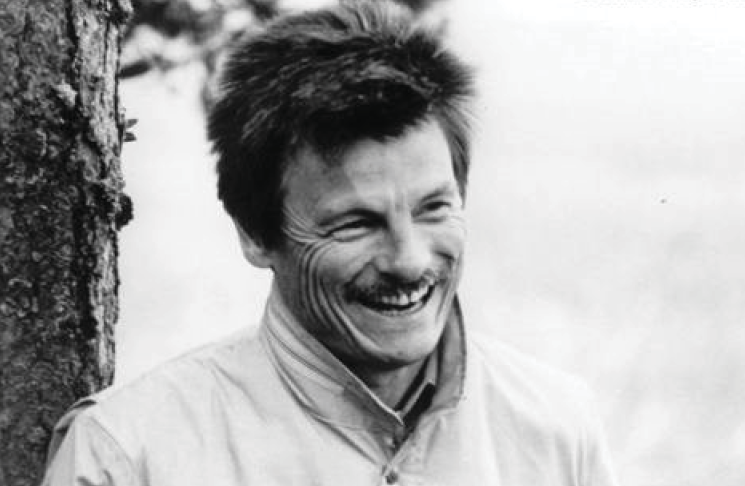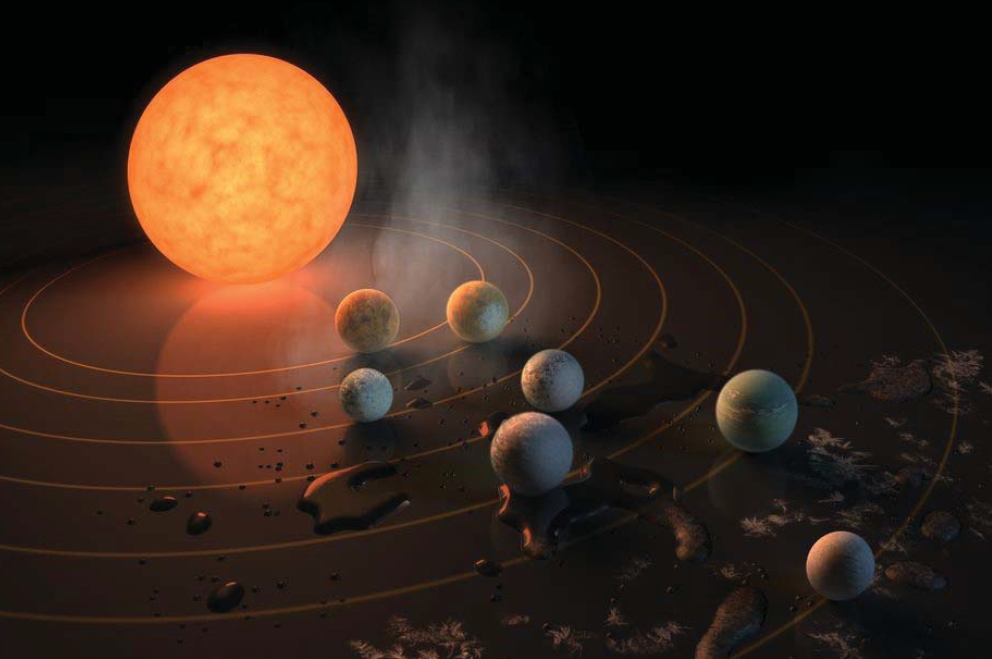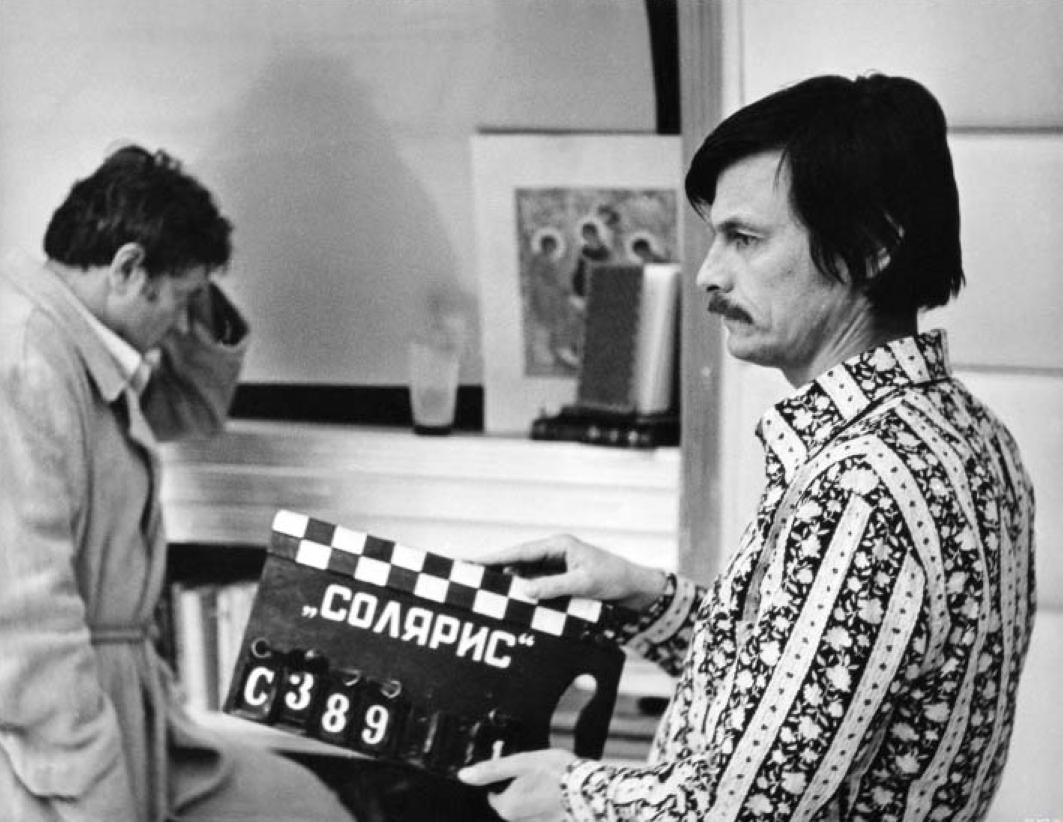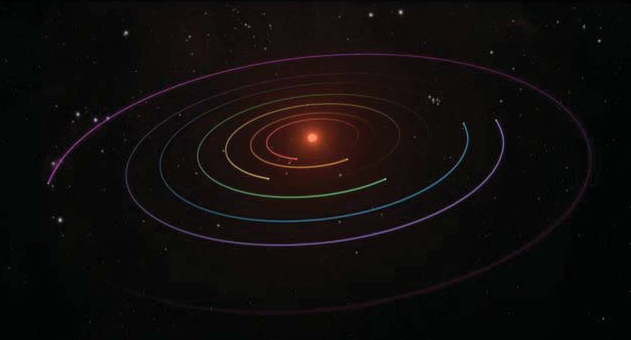Exoplanets. A Nonexistent Tarkovsky Film’s Soundtrack
Published in: 28. The Reefs of ConflictTo start with, I will name three planets, each with its own period of revolution around the world’s axis. Three intersecting spheres for this discussion.
First. Andrei Tarkovsky. In 2017, humanity celebrated his jubilee, eighty-five years from the date of his birth.
Second. Ryuichi Sakamoto, async. In 2017, the Japanese musician released an album with that title. His first album after an eight-year hiatus. He described the album as a “soundtrack to a nonexistent film by Andrei Tarkovsky.”

Third. Exoplanets. In 2017, twenty-five years had passed since the moment when people became aware of the discovery of the first planetary system belonging to another star.
These three factors and facts are interconnected, and, as phenomena on a global scale, are intertwined in space and time. The connections are not always obvious.
Andrei Tarkovsky’s name needs no explanation, and we will turn to his personality and work a little later. The other two phenomena require details.
Ryuichi Sakamoto, one of Japan’s most prominent and most famous composers, belongs, like Andrei Tarkovsky, to the whole world. He is open to mankind’s diversity of cultures and traditions in musical art and in other areas of human creativity. In his new album, the musician, who has worked with many filmmakers, gives the world music inspired by Andrei Tarkovsky’s cinematic language and attitude.

A brief curriculum vitae.
Ryuichi Sakamoto (01/17/1952, Tokyo, Japan) is a musician, composer, producer, co-founder of the cult group Yellow Magic Orchestra, a pioneer in electronic computer music in the late 70s and early 80s. Having received an academic European musical education at Tokyo National University of Fine Arts and Music with a degree in composition, he began to study the theory of classical, electronic and ethnic music. Nicknamed “Professor,” he is characterized by self-irony. He works in a variety of genres, including neoclassical, pop, electronic, ambient, experimental music and academic avant-garde. He wrote music for the opening of the Olympic Games in Barcelona. He is the author of soundtracks for many films by the most famous directors of our time, including Bernardo Bertolucci and Alejandro Inarritu. He’s an Oscar winner, and has also received multiple Golden Globe, Grammy and BAFTA awards, as well as many other honors. Since 1990, he has lived in New York.
In 2014, his vigorous activity was suddenly interrupted by a terrible diagnosis of throat cancer. However, after a year of treatment, he returned to his career with a triumphant soundtrack for the Oscar-winning film “The Revenant” by Alejandro González Iñárritu. async was the first album after the illness and Japan’s devastating 2011 earthquake, experienced by the composer in Tokyo. For Sakamoto, this experience opened a door to a new dimension of knowledge of being.
Now let’s move to another orbit and talk about exoplanets. These are planets that revolve around other stars besides the Sun. Until recently, scientists did not possess sufficiently sensitive observational means to perceive such planets. Our solar system was the only one we knew about reliably. Fiction writers and dreamers, looking into the sky, of course, always imagined multiple worlds, including those inhabited by living and intelligent creatures. Sometimes even the planets themselves could have a mind, like the “Solaris” of Stanislav Lem and Andrei Tarkovsky. But we did not have any observational data confirming the presence of even one planet for even one other star.
The means of observation improved, and in 1992 a work was published on the reliable detection of the first exoplanets in a pulsar — the remnant of a star after a supernova explosion. In 1995, the first planet belonging to a “normal” star was reliably confirmed.
At the moment (as of the end of 2017) about four thousand exoplanets have been definitely discovered, and there are several thousand more good candidates. Even the closest star to us, Proxima Centauri, has a planet. In rare cases, these planets can be recorded in an optical range using telescopes, but, as a rule, exoplanets are detected by various indirect methods, for example, by observing a decrease in the brightness of a star when a planet passes through its disk, or by measuring a star’s movement under the gravitational influence of its massive satellites.

It turns out that other planetary systems can be very different from ours. For example, our gas giants — Jupiter and Saturn — are quite far from the Sun, while in other systems so-called Hot Jupiters have been discovered — gas giants located so close to their stars that their upper layers heat up to several thousand degrees, and a year for such a planet lasts only some dozens of hours.
Why is it important to study other planetary systems? Not only for the sake of pure science, but also in order to understand our own solar system, to understand the Earth, its past and future. We see the solar system in its current state. Looking at other systems, we see them at the most different stages of formation, evolution and death. Until now, we had a single object for research, which is too few for an observational science like astronomy. Now, we have at least several thousand objects and can collect statistical data and determine patterns. And exoplanetary astronomy is now at the very beginning of its rapid development.
Having noted these three areas, let’s consider connections and resonances among them.

Andrey
Tarkovsky.
Nikolai Boldyrev in the introduction to his book “The Sacrifice of Andrei Tarkovsky” writes: “There are many stories about random spying on how mature master Tarkovsky would play, for a long time, like a child, in streams, ponds, dams, watercourse, lakes, would build stone gardens or in general play games no one could understand, on the fringes of forests or in the shallows at bends in rivers. He would manipulate twigs, leaves, grasses, pebbles, rough and smooth, warm and cold, moist and dry, the strange vibrations emanating from unapproachable essences, sounds and messages, rare and always unique shades of luminescence, angles never heard of and beyond meaning… He would retreat into long observation of the stains on some old, ancient wall, or of wrinkles in trees, or of the play of shadows, or would passionately watch the “inner life” of a beetle crawling from one anonymity to another… That was also the way he listened…”
This close scrutiny, listening, attentiveness to the present moment — a mindfulness inherent in Tarkovsky — is capable of broadening the human consciousness to the depths of space and the breadth of time. Such mindfulness unchains consciousness from the habit of sliding without noticing, and yet judging, while present only discretely, from time to time. And such mindfulness allows a person to hear, in himself, that inner silence which is the source of everything and in which only the voices of stars and herbs are audible. Living life, not ideas about life. Truly being present in your own life. Then distant connections are revealed — connections that don’t lie on the surface but flow out of the deep, essential unity of all that exists. And this is more than pretty words — it’s real.
Thus the winter landscape on Bruegel’s canvas in “Solaris” has a resonance with a picture of Chris’s childhood memory of his mother. The two landscapes, it would seem, have nothing to do with what is happening on Solaris, and yet these scenes penetrate each other, shine through each other, because they are one. This is how the artist sees, awakened to a luminous unity that lies in the depths of the apparently separate. The same unity is emphasized by Eduard Artemyev’s soundtrack, with the same music used for both of these episodes. This is the music that Ryuichi Sakamoto responds to in async. But more on that later.
Let’s recall a scene from the film “Sacrifice”: a boy is sleeping in his room, and light from a window and a curtain sway in time with his breath. The human, inner, intimate space is one with outer, cosmic space. Substances, objects, creatures in Tarkovsky’s films have a cosmic, primordial essence. Life’s fullness emerges as a manifestation of cosmic consciousness. In such an awareness, the smallest speck of airborne dust, illuminated by the sun, is found important, vibrant, close, like a galaxy at a distance of millions of light-years, because everything that consciousness can embrace is you yourself.
And Tarkovsky’s exoplanet Solaris, which may be the main character of the film of the same name, penetrates the subconscious of people in the space station, first extracting their most awful hosts of phantoms. But in the finale — which is not in Lem’s book, and for which Lem criticized Tarkovsky, because film’s main idea is the opposite of the novel’s — Solaris becomes Chris Kelvin’s most valuable and true reality. We find it emotionally shocking that an alien mind created the world toward which the hero’s soul passionately strove — returning home, to himself, restoring integrity. In this, Tarkovsky’s cosmism, in my opinion, is superior to Lem’s, in that Tarkovsky postulates the unity of a human consciousness, from the Earth, with an entire distant planet.
I think this may be what Sakamoto is saying in the async track “solari.” Timbrally and in the dynamics of the sonic canvas, it echoes J.S. Bach’s Choral Prelude in F minor, arranged by Eduard Artemyev for “Listening to Bach (Earth)” in the movie soundtrack.
Ryuichi
Sakamoto.

He is Japanese by birth, Buddhist and Shinto in spirit, which means that silence between notes and emptiness between forms is not an abstract idea for him. It was in his music that I first discovered the endless spaces between notes in barely noticeable pauses and sudden irregularities in rhythm. “As soon as you make a piano sound, it begins to vanish, vanishing into noise. You can’t tell when it becomes noise, when it’s gone. That’s the area I’m interested in,” says Sakamoto.
When we observe such transient processes, we can go beyond the limits of the human mind, which thinks in discrete categories, dividing and defining. We can go out to where boundaries blur, to where the indefinable reigns — out to Being, as it is. In Buddhism, emptiness is not nothing, but one of its possible definitions is the absence of concepts. So the vacuum is not an absolute void. It holds spontaneous fluctuations of fields. At the beginning of the Universe, before the Big Bang, the vacuum underwent an inflationary expansion, after which substance appeared, arising from the vacuum, pregnant with matter and energy. The most intimate things, comprehended in the depths of self-contemplation, merge with the all-encompassing and cosmic.
At live concerts by Ryuichi Sakamoto, a miracle happens. I recall my own experience at his performance in Hamburg in 2011. The huge black empty space of the hall. A note falls. And lasts, and shines. And, in fading, enhances the radiance of emptiness. Sound passes into light. Light passes into sound. Endless silence and black emptiness tower above this, nourish this, from their clearly present density give rise to mutually flowing sound and light. Emptiness and blackness shine, shaded by luminous sound, sounding light. The fading of sound makes this radiance completely distinct. This experience of being present at the quivering moments of the creation of being is inexpressible. Amazing. Magical.
Sakamoto masterfully enhances our ability take pleasure in contemplating the Absolute = Vacuum = Darkness = Mother, which gives birth to the manifested world before our very eyes.
So the cosmic appears not only in space as such, but nearby, close. And where does the cosmos begin, if not in our heart, uniting in kinship all that exists, crystallized from its emptiness. Such an understanding leads Sakamoto to trust nature, space, all that is. “I went to see one of those pianos drowned tsunami water near Fukushima, and recorded it,” he says. “Of course, it was totally out of tune, but I thought it was beautiful. I thought: ‘Nature tuned it.’”
This is an intimate relationship with being, with the Universe, which an adult tends to forget, but which is the essence of a child’s life. Ryuichi Sakamoto demonstrated this with renewed vigor after a terrible illness. Death is a teacher, and the musician said of this experience that for the first time he felt the breath of death on his face. And his first work after his illness was the soundtrack for Alejandro González Iñárritu’s film The Revenant. The main musical theme, according to Sakamoto, is the beating of his own heart on the border between life and death. And this music recalls the scene with the sleeping boy from The Sacrifice, which I spoke about, despite the subjects being emotionally opposite.
Sakamoto says he has watched the films of Andrei Tarkovsky, his favorite director, many times over his life. “I have watched them again and again throughout my life, but recently I like his films more than before, maybe because of age, maybe the disease…related to the concepts of his films — life and death and memories,” says Sakamoto in an interview. The async album is really the soundtrack to a nonexistent film by Tarkovsky, with both artists sharing an ability to look and listen attentively to being, to see the universe in a speck of dust, and to be one with their own life. “My first desire when making this album was just to listen to, and enjoy, the sounds of everyday objects. I had returned to a point in life where I wanted to simply hear the sounds of objects, and that included thinking of musical instruments as everyday objects,” says Sakamoto. Listening to sound as such, examining the transitions of tones and frequencies, the changing durations, the fading and appearance of sounds — that is the best way to listen to Ryuichi Sakamoto’s async album.
Traveling from track to track, the listener follows the path of evolution from a single source through disintegration, decay and dying, through asynchronism and chaos to a new attainment of integrity and unification with the self on a cosmic level.
His first track, “andata,” majestically abides in unity, step one. The second track, “disintegration” — step two — is separation. The experience of the global in the simple, the experience of unity, also implies the wisdom of perceiving the whole’s division into parts, which doesn’t destroy the whole. The whole is divided into parts in harmonic resonance — the resonance of harmonics, of vibration frequencies related to each other as integers.
Artists are guided by an awareness of indissoluble unity as the main principle of the universe. An awakened consciousness of both inspires us to discover deep connections. On that note, I’d like to share an amazing perspective provided by representatives of adherence to a different paradigm — the scientific.
Forty light-years from the Sun is an ancient solar system with a red dwarf as its central star. The system, Trappist-1, has seven planets similar in size to the Earth. Three of them are in the habitable zone — that is, their surface may have conditions suitable for the existence of liquid water. The planets are located so close to their sun and to each other that there is a danger of their collision and destruction.
Yet the system is stable. What keeps it from falling apart? Resonance. The planets’ orbital form an amazingly precise progression. Their frequencies correlate as 2:3:4:6:9:15:24. That is, as the farthest planet makes two orbits, the next makes three, and so on.
And resonance is what makes music and rhythm.
Scientists have created a simulation1] that makes the planets’ orbital frequencies audible for the human ear by multiplying the frequencies by 212 million times. A note sounds every time each planet passes in front of the system’s star. The scientists also added a percussion sound each time a planet overtakes its neighbor. At the end comes a sound based on the Trappist-1 star’s brightness, sped up many times.
It’s like a supergroup where all seven members play synchronously and harmoniously.
Listen to Sakamoto’s “disintegration,” with its space refinedly marked by notes that lag but resonate with each other, united in a single system of harmonious resonance, and you’ll hear how this music written for a nonexistent film by Andrei Tarkovsky — music suffused with the director’s sense of the universe — establishes a perfect consonance with the exoplanets’ music. In essence, these are the same composition. The first is written by an earthly composer, and the second is created by the cosmos. And both are the soundtrack to a film by Tarkovsky, with whom Ryuichi Sakamoto didn’t get to collaborate on the plane of earthly existence.

[1] The authors of the computer simulation are Daniel Tamayo, a postdoctoral researcher at University of Toronto Scarborough, and Matt Russo, an astrophysicist who is also a musician.
The music of Trappist-1’s exoplanets:
https://www.youtube.com/watch?v=WS5UxLHbUKc
Ryuichi Sakamoto’s album async:
https://www.youtube.com/watch?v=pygwK0sBUdM&list=PLlxVAExh_bYbnN6c4q1EJxcv559obwOBt

Speak Your Mind